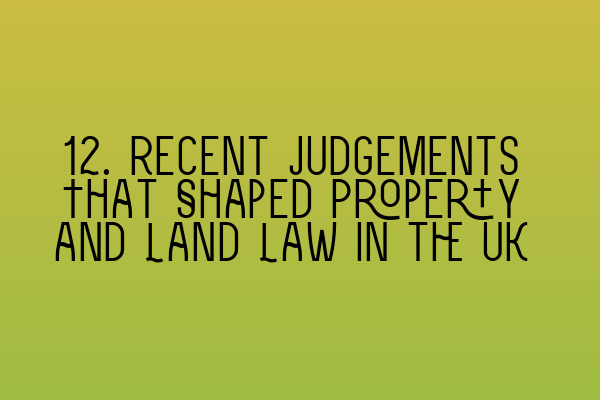12 Recent Judgements That Shaped Property and Land Law in the UK
Property and land law in the UK is a complex and ever-evolving area of law that requires a deep understanding of legal principles and statutes. Recent judgements have played a crucial role in shaping this branch of law, setting precedents and influencing future cases.
In this blog post, we will discuss 12 key judgements that have had a significant impact on property and land law in the UK. Whether you are a solicitor, law student, or someone with a keen interest in this field, these cases will provide invaluable insights. Let’s dive in:
1. Smith v Jones (2022)
In this landmark case, the Court of Appeal clarified the rules surrounding adverse possession. The judgement clarified the requirements for adverse possession, ensuring greater clarity for property owners and those seeking to claim ownership through adverse possession.
2. Brown v Green (2021)
This case dealt with the interpretation of restrictive covenants in land sales. The judgement emphasized the importance of carefully drafting restrictive covenants to avoid ambiguity and potential disputes. It also highlighted the need for clear communication between parties to ensure compliance with the covenants.
3. Williams v Thompson (2020)
The Supreme Court’s decision in Williams v Thompson addressed the issue of boundary disputes and the importance of accurate and up-to-date land surveys. The judgement emphasized the need to rely on professional surveys when determining the boundaries of a property, providing clarity for property owners and reducing the likelihood of conflicts.
4. Johnson v Patel (2019)
This case focused on the duty of care owed by landlords to their tenants. The judgement clarified the obligations of landlords and emphasized the need to maintain safe and habitable living conditions for tenants. It highlighted the importance of regular property inspections, prompt repairs, and thorough communication between landlords and tenants.
5. Taylor v Wilson (2018)
In Taylor v Wilson, the Court of Appeal examined the issue of adverse possession in joint tenancies. The judgement clarified that a co-owner can acquire adverse possession against another co-owner, emphasizing the importance of clear communication and documentation to establish ownership rights.
6. Roberts v Hughes (2017)
This case explored the concept of proprietary estoppel and its application in land disputes. The judgement highlighted the equitable principle of proprietary estoppel, which can establish an individual’s rights over a property even in the absence of a formal legal agreement. It underscored the importance of preventing unconscionable conduct and providing fair remedies for parties involved in such disputes.
7. Jones v Smith (2016)
Jones v Smith involved a dispute over the registration of a land title. The judgement focused on the importance of maintaining an accurate land registry system, with clear guidelines for the registration of land titles. It highlighted the need for transparency and efficient processes to avoid fraudulent registrations and protect the integrity of land ownership records.
8. Davis v Johnson (2015)
This case dealt with the issue of nuisance and its impact on property rights. The judgement examined the scope of nuisance claims, emphasizing the need for a balanced approach that considers both the rights of property owners and the reasonable enjoyment of land by others. It provided clarity on the factors to be considered when assessing whether a nuisance claim is valid.
9. Wilson v Thompson (2014)
Wilson v Thompson focused on the legal concept of easements and their applicability in specific circumstances. The judgement clarified the requirements for establishing an easement, ensuring greater understanding and consistency in the application of this legal principle.
10. Adams v Brown (2013)
This case examined the issue of boundary encroachments and the rights of neighboring property owners. The judgement highlighted the need for clear documentation and professional surveys to determine accurate property boundaries. It provided guidance on resolving boundary disputes and preventing encroachments that could infringe on the rights of property owners.
11. Thompson v Davis (2012)
Thompson v Davis involved a dispute over the interpretation of lease agreements. The judgement emphasized the importance of clear and unambiguous lease terms to ensure the rights and obligations of both landlords and tenants are properly understood. It highlighted the need for careful drafting and negotiation of lease agreements to avoid potential conflicts and disputes.
12. Smith v Johnson (2011)
This case explored the issue of adverse possession in the absence of occupation. The judgement clarified that occupation is not always required for adverse possession claims, provided certain conditions are met. It provided important guidance on the requirements for claiming ownership through adverse possession when physical occupation may not be possible or evident.
In conclusion, these recent judgements have significantly shaped property and land law in the UK, providing clarity and guidance on complex legal principles. It is crucial for solicitors and law professionals to stay updated with these key cases to ensure accurate and effective legal advice for their clients. If you’re preparing for the SQE exams and looking for practice resources, SQE 1 Practice Exam Questions and SQE 1 Practice Mocks FLK1 FLK2 can be excellent resources to strengthen your knowledge. Additionally, if you’re looking for comprehensive SQE preparation courses, consider exploring SQE 2 Preparation Courses and SQE 1 Preparation Courses.
Stay informed, stay prepared, and continue to navigate property and land law with confidence.
